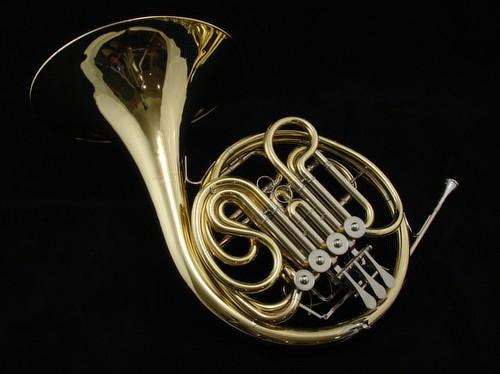Interested in learning about the double French horns? Read our guide for more facts and information…
The French horn is an instrument made of brass, tubing and a flared bell. The interesting thing about a French horn is that it comes in two variations, a single and a double French horn. Whereas the single French horns come as F and B flat horns separately.
History of the double horn
The French horns or the cor de chasse originated in the 17th century. According to the ‘Brief History of Horn Evolution’ the credit for inventing the double French horns in the 1800s was given to Fritz Kruspe and Edmund Gumpert. The German inventor, Fritz Kruspe is said to have combined the pitches of the F and B- flat horn in the year 1900.
The double French horns come in two wrap styles, Kruspe and Knopf named after the pioneers of developing the instrument.
The modern French horn and the double French horn that we know of today, was developed in the nineteenth century when valves replaced the crooks. Heinrich Stoelzel and Friedrich Blühmel are the two people who are given credit for inventing the valve for the French horn.
Mechanism
The double French horn incorporates the F and B-flat keys into one instrument making it more convenient and easier. These separate sets are the sides of the double French horn.
The player will use his thumb to operate the 4th valve that switches from F to B key. The fourth valve changes the length of the tubing which changes the tone from a dark, warm one to a lighter tone. The fourth valve also adjusts the main valves to use equal slide lengths.
The most important parts of a double French horn are the following.
1. Mouthpiece
The hornist presses his lips against the mouthpiece which is a small metallic piece that produces the first sound of the horn. With the press, a vibration is created inside the mouthpiece which enhances the sound of the horn.
2. Lead Pipe
The lead pipe is a long length of tube which is used to place the mouthpiece. It transforms sound quality of the horn. When the sound echoes through the lead pipe is leads to an overtone series. When playing, this occurs when the tubing is added to the mouthpiece and the player feels the buzz with pitches.
3. Tubing
The tubing of the horn shapes the sound from the buzz and the vibration. Each different length of tube is combined distinctly to create the variations in the pitch and different tones.
4. Valves
The valves are operated manually by the player with the fingers of the left hand. They control the flow of air through. Variation in pressing leads to different routes for the air flow; it enters some areas and is restricted from others. This mechanism makes the tubing shorter or longer depending on the flow and alters the pitch.
5. Bell
The bell is a large flared cone made from metallocated at the end of the horn’s tubing. The bell amplifies the sound created in the tubing, making it louder for the audience.
There are many good brands of double French horns available such as King, Conn, Paxman and Holton among others. Purchase a horn from a reliable name to get quality and great playing experience.





